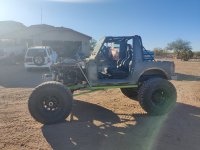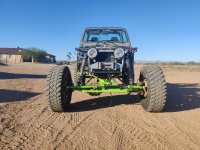BadDecisions
Silver Member
Non tractor application, but it may become a tractor application depending on what happens with this valve...while I've used and repaired the hydraulics on the tractor, this is my first venture into building a system from scratch.
I converted an off road 4x4 toy to full hydraulic steering, using a Char-Lynn 291-5012-001 - 5 port, non load reaction power beyond steering valve, with a double ended balanced steering cylinder and fed it all with a stock automotive power steering pump. I used the PB valve because I had gotten a new one dirt cheap from a shop that went out of business. I initially had just plugged the PB port, found the pump got to be in excess of 400*F within 30 seconds, and had a pump failure shortly after while trying to figure out what was going on.
I did a bunch of searching, learned that the tank port is effectively blocked off when no steering input is given, and blocking the PB port made the valve a closed center. I now have the hoses from the PB and Tank ports tee'd together at the filter input, and filter output flows to reservoir tank. Pump seems happy, steering works well in garage.
1st test drive - front end is all over the road at anything above 25mph, acting as if there is extreme toe in/out. Virtually impossible to keep it running in a straight line. I've played with the alignment a bunch, and got it better, but still nowhere near "right". This isn't something that I intend to be able to run down the freeway, or on pavement at all really, but running access roads to the trails at 10mph is gonna be a bummer too.
Now I'm wondering if using a PB valve without having a need for the PB function is somehow causing an issue with all this? Is my hose routing, with the PB and tank hoses tee'd together causing a problem? Is it possible that the PB is somehow now back feeding pressure through the T port?
I had read where there is a PB sleeve that's supposed to be installed, but I also couldn't really find a clear answer on whether this is a requirement on all PB valves, or if it's needed when not using the PB function. It also doesn't look like either the PB or T port on my valve could have that sleeve added anyways, as in the ports aren't machined in a way that would provide room for a sleeve to drop down in to them. I have considered just ditching this valve, and buying a non-PB valve, but I really dislike just throwing parts at a problem without a clear understanding of why.
I converted an off road 4x4 toy to full hydraulic steering, using a Char-Lynn 291-5012-001 - 5 port, non load reaction power beyond steering valve, with a double ended balanced steering cylinder and fed it all with a stock automotive power steering pump. I used the PB valve because I had gotten a new one dirt cheap from a shop that went out of business. I initially had just plugged the PB port, found the pump got to be in excess of 400*F within 30 seconds, and had a pump failure shortly after while trying to figure out what was going on.
I did a bunch of searching, learned that the tank port is effectively blocked off when no steering input is given, and blocking the PB port made the valve a closed center. I now have the hoses from the PB and Tank ports tee'd together at the filter input, and filter output flows to reservoir tank. Pump seems happy, steering works well in garage.
1st test drive - front end is all over the road at anything above 25mph, acting as if there is extreme toe in/out. Virtually impossible to keep it running in a straight line. I've played with the alignment a bunch, and got it better, but still nowhere near "right". This isn't something that I intend to be able to run down the freeway, or on pavement at all really, but running access roads to the trails at 10mph is gonna be a bummer too.
Now I'm wondering if using a PB valve without having a need for the PB function is somehow causing an issue with all this? Is my hose routing, with the PB and tank hoses tee'd together causing a problem? Is it possible that the PB is somehow now back feeding pressure through the T port?
I had read where there is a PB sleeve that's supposed to be installed, but I also couldn't really find a clear answer on whether this is a requirement on all PB valves, or if it's needed when not using the PB function. It also doesn't look like either the PB or T port on my valve could have that sleeve added anyways, as in the ports aren't machined in a way that would provide room for a sleeve to drop down in to them. I have considered just ditching this valve, and buying a non-PB valve, but I really dislike just throwing parts at a problem without a clear understanding of why.


